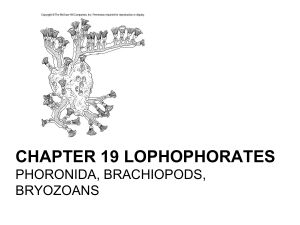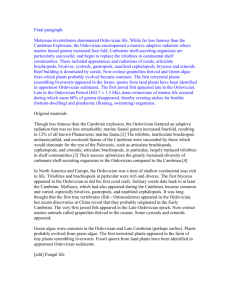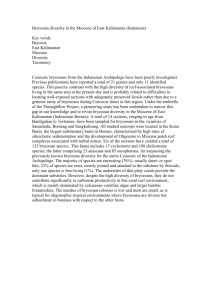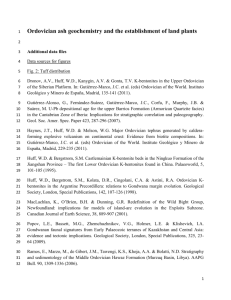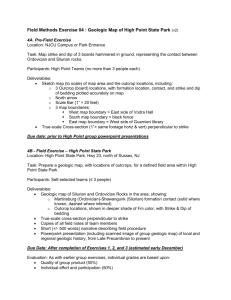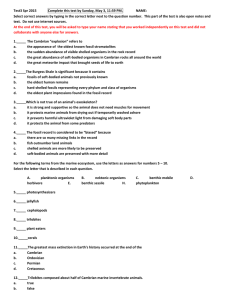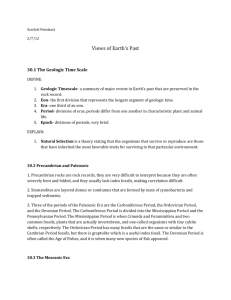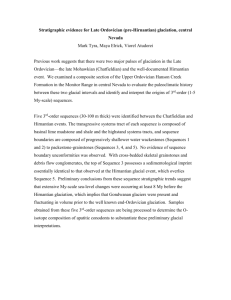Brachiopods
advertisement
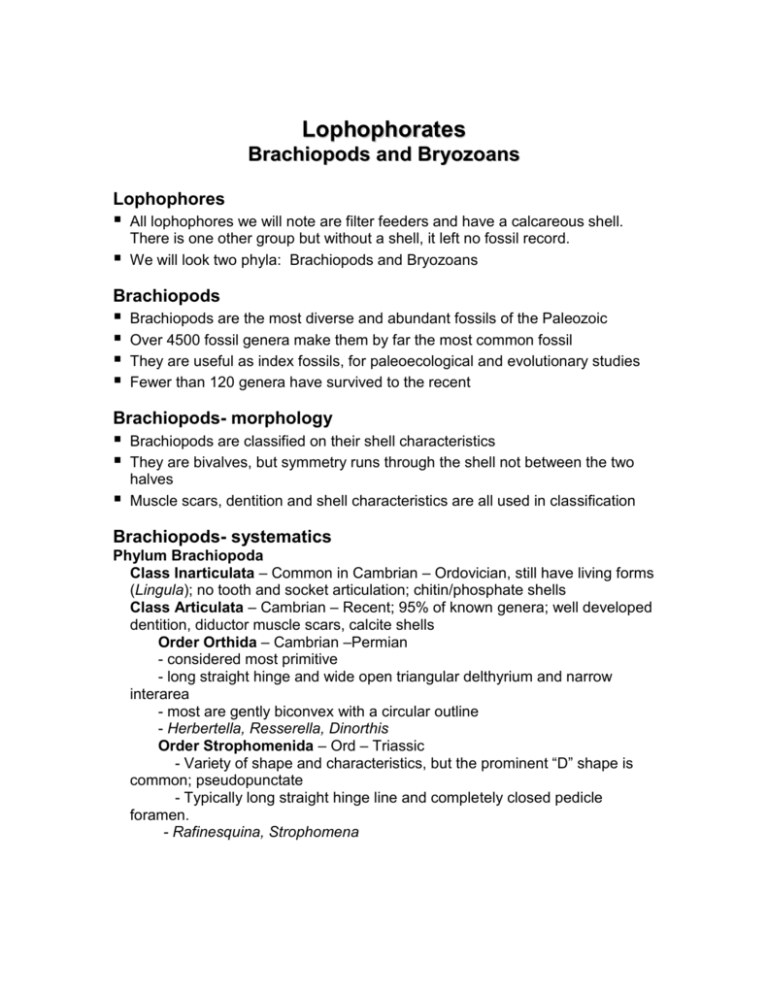
Lophophorates Brachiopods and Bryozoans Lophophores All lophophores we will note are filter feeders and have a calcareous shell. There is one other group but without a shell, it left no fossil record. We will look two phyla: Brachiopods and Bryozoans Brachiopods Brachiopods are the most diverse and abundant fossils of the Paleozoic Over 4500 fossil genera make them by far the most common fossil They are useful as index fossils, for paleoecological and evolutionary studies Fewer than 120 genera have survived to the recent Brachiopods- morphology Brachiopods are classified on their shell characteristics They are bivalves, but symmetry runs through the shell not between the two halves Muscle scars, dentition and shell characteristics are all used in classification Brachiopods- systematics Phylum Brachiopoda Class Inarticulata – Common in Cambrian – Ordovician, still have living forms (Lingula); no tooth and socket articulation; chitin/phosphate shells Class Articulata – Cambrian – Recent; 95% of known genera; well developed dentition, diductor muscle scars, calcite shells Order Orthida – Cambrian –Permian - considered most primitive - long straight hinge and wide open triangular delthyrium and narrow interarea - most are gently biconvex with a circular outline - Herbertella, Resserella, Dinorthis Order Strophomenida – Ord – Triassic - Variety of shape and characteristics, but the prominent “D” shape is common; pseudopunctate - Typically long straight hinge line and completely closed pedicle foramen. - Rafinesquina, Strophomena Order Pentamerida – Cambrian – Devonian, index for the Silurian - Most are biconvex with a curved hinge line and small uncovered delthyrium; impunctate - The large scooped spondylium, large septum and crurallium complex divides the ventral shell into 5 parts Order Spiriferida – Ord- Jurassic - spiral brachidia, highly biconvex, radial costae, large interarea on ventral valve and often a long hinge line - Microspirifer, Neospirifer, Atrypa Order Rhynchonellida – Ord – Recent - short, bent hinge line, pointed beak, Most have heavy ribs,deep fold and sulcus Order Terebratulida – Dev – Recent “Lamp shell” brachiopods, strongly biconvex with large pedicle foramen, beak overhangs the short hinge line with no interarea. Best known living form. Brachiopods- paleoecology Exclusively sessile benthic marine forms Found in shallow marine and in epicontinental platform seas Some inarticulate forms tolerate brackish water, but most require clear water with currents to bring food and oxygen to them and carry waste away. Brachiopods - evolution Different groups characterize different periods They were plentiful enough that their evolution can be traced and they are widespread enough to be excellent index fossils for some periods. Brachiopods- biostratigraphy Cambrian – Lingulid and Orthid Ordovician – Strophomenides Silurian – Pentamerids Devonian – Spirifers Mississippian – mixture of Spirifers and Productids Pennsylvanian/Permian – Productids Less important in the Mesozoic/Cenozoic Bryozoans Bryozoans are colonial animals that have not always been classified as lophophores. The individual bryozoan animal (zooid) is very small – about 1mm long Two of the three classes have a calcareous colonial skeleton that is preserved in the fossil record. The structure of the colonial skeleton is what separates the different orders Bryozoans -systematics Phylum Bryozoa Class Stenolaemata – Ordovician – Recent Zoocia are long and tubular, highly calcified and grow throughout the life of the colony Bryozoans -systematics Phylum Bryozoa Class Stenolaemata – Ordovician – Recent Order Trepostomata – Ordovician - Triassic Bryozoans -systematics Phylum Bryozoa Class Stenolaemata – Ordovician – Recent Order Trepostomata – Ordovician – Triassic Formed massive branching colonies in the Paleozoic. Made up of three kinds of zoocia. Contributed large parts of some Ord. limestones. Survived the Paleozoic extinctions to become extinct in the Triassic. Bryozoans -systematics Phylum Bryozoa Class Stenolaemata – Ordovician – Recent Order Trepostomata – Ordovician – Triassic Order Cryptostomata – Ordovician - Permian Bryozoans -systematics Phylum Bryozoa Class Stenolaemata – Ordovician – Recent Order Trepostomata – Ordovician – Triassic Order Cryptostomata – Ord – Permian Large numbers before the Late Ord. extinctions and then persisting to the end of the Permian when they became extinct. Characterized by short autopores with a vestibule separated from the inner zoocium by a hemiseptum. Bryozoans -systematics Phylum Bryozoa Class Stenolaemata – Ordovician – Recent Order Trepostomata – Ordovician – Triassic Order Cryptostomata – Ord – Permian Order Fenestrata – Ordovician – Permian Bryozoans -systematics Phylum Bryozoa Class Stenolaemata – Ordovician – Recent Order Trepostomata – Ordovician – Triassic Order Cryptostomata – Ord – Permian Order Fenestrata – Ordovician – Permian Especially abundant in the Mississippian and became extinct at the end of the Permian. Zooaria are arranged in a lacy network. Key Genera Acrhimedes and Fenestella Bryozoans -systematics Phylum Bryozoa Class Stenolaemata – Ordovician – Recent Order Trepostomata – Ordovician – Triassic Order Cryptostomata – Ord – Permian Order Fenestrata – Ordovician – Permian Order Cyclostomata – Ordovician – Recent Bryozoans -systematics Phylum Bryozoa Class Stenolaemata – Ordovician – Recent Order Trepostomata – Ordovician – Triassic Order Cryptostomata – Ord – Permian Order Fenestrata – Ordovician – Permian Order Cyclostomata – Ordovician – Recent Minor group in the Paleozoic, but survived to become on of three living orders Bryozoans -systematics Phylum Bryozoa Class Stenolaemata – Ordovician – Recent Order Trepostomata – Ordovician – Triassic Order Cryptostomata – Ord – Permian Order Fenestrata – Ordovician – Permian Order Cyclostomata – Ordovician – Recent Order Gymnolaemata – Ordovician – Recent Minor group similar to the Cyclostomes Bryozoans -systematics Phylum Bryozoa Class Stenolaemata – Ordovician – Recent Class Gymnolaemata – Ordovician – Recent Bryozoans -systematics Phylum Bryozoa Class Stenolaemata – Ordovician – Recent Class Gymnolaemata – Ordovician – Recent Most living forms belong to this class Bryozoans -systematics Phylum Bryozoa Class Stenolaemata – Ordovician – Recent Class Gymnolaemata – Ordovician – Recent Most living forms belong to this class. Have cylindrical or box-like enclosures around the zooids. Each zooicium remains a fixed size and discrete zooicia are added as the colony grows. Only one of the two orders is geologically significant Bryozoans -systematics Phylum Bryozoa Class Stenolaemata – Ordovician – Recent Class Gymnolaemata – Ordovician – Recent Order Cheilostomata – Jurassic - Recent Bryozoans -systematics Phylum Bryozoa Class Stenolaemata – Ordovician – Recent Class Gymnolaemata – Ordovician – Recent Order Cheilostomata – Jurassic – Recent Comprise the most diverse group of living bryozoans. Box-like calcareous zooids have an operculum. Bryozoans - ecology Bryozoans are filter feeders and tend to live in warm, clear water. Bryozoans - ecology Bryozoans are filter feeders and tend to live in warm, clear water. They attach to a firm substrate and are common residents of Paleozoic reef complexes. Bryozoans - evolution Bryozoans evolve on the level of the colony rather than on th e i n d i v i d u a l Bryozoans - evolution Bryozoans evolve on the level of the colony rather than on th e i n d i v i d u a l Evolutionary changes have been few, and the bryozoa, as a group, have been stable over long periods of time.
